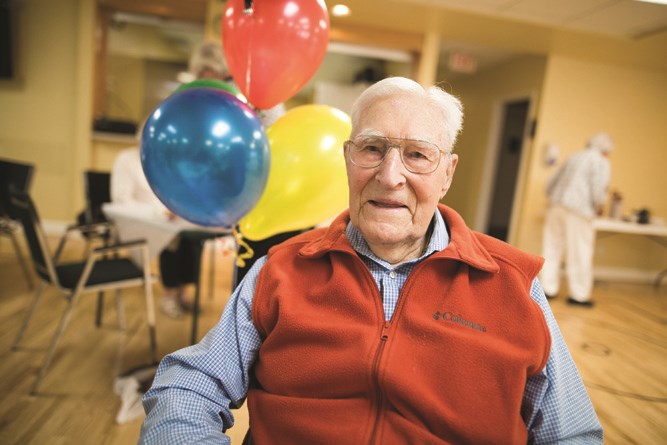Winston Churchill Parker grew up on a mixed farm in the Red Deer Lake area and after the Second World War returned to the Millarville area where his parents lived. He tried to resume his passion for ranching and took on prominent roles in various community organizations. “We were brought up in the English tradition to be proud of our roots and our country,” wrote Parker in his autobiography Saddles and Service. “If our country needed us, we would volunteer. We would show up and be counted, and we did.” When Parker was 21, he and his friend Bill Wallace volunteered for the Royal Canadian Air Force in 1939. Winston trained for almost a year in wireless, bombing and gunning schools in Manitoba, Saskatchewan and Calgary. After he graduated as an airman, Parker was sent to England. On his first leave in London, he met up with his uncle, Reginald Parker, who was Prime Minister Winston Churchill’s personal chauffeur. What a thrill it was when Parker’s uncle introduced him to Churchill, who he had been named after. Parker flew 12 successful missions as a wireless operation air gunner in the Wellington bomber. Part of each bombing raid was dropping propaganda leaflets. Parker recalls one bombing raid over the Ruhr Valley. Each leaflet was shaped like an oak leaf with a message warning the German people: “It is now autumn and your soldiers are dropping as fast as the leaves are falling off the trees in Russia.” Parker’s Wellington bomber was shot down on his 13th bombing mission. He parachuted down in enemy territory and was captured as a POW. He spent more than three years as a prisoner at Stalag VIIIB, now Poland. When he arrived, there were 120 to 130 air force prisoners. That number later increased to 1,000. In Saddles and Service, Winston tells of exceedingly harsh conditions such as having to wear handcuffs every day for 11 months to thwart any escape efforts. Their hands became very swollen as a result of the loss of circulation. The one good thing was when Red Cross parcels came in, fortified with vitamin food. Their camp seldom received Red Cross parcels because the bombings had taken out the railroads. The other highlight Parker remembers was getting parcels from family in the mail. They were allowed four parcels a year of what they called clothing parcels - a pair of socks and a clean shirt. Allied prisoners would sporadically get an issue of boots from Britain. Parker recalls getting a good-fitting pair of boots and had metal studs put on the soles so they’d last longer. That was a very wise decision because in Jan. 22, 1945 their group was marched at gunpoint by the German guards. In three cold winter months, these prisoners walked approximately 1,000 kilometres, often scrounging for food in the fields, trudging in worn-out sodden shoes, attempting to help each other in their struggle to survive. This Death March was a grueling, harrowing long drawn-out torture. On April 11, 1945 U.S. troops liberated Parker and his fellow prisoners. “I was walking on my bare feet. I had worn the boots right through until there was nothing left for soles,” he wrote. “When I got to England, though, I still had these boots on” Parker weighed less than 98 pounds and spent more than six weeks in hospital recuperating before he was well enough to return to Canada. When Parker returned to the Foothills area, his parents had purchased land three miles west of Plummer’s Road where Joe Standish had lived. Parker returned working at Home Oil until he was able to buy a farm by the river crossing, across from Christ Church, continuing in his father’s footsteps of raising cattle and horses. After the war, Parker donated a miniature bronze statue in honour and memory of all air crew ex-prisoners of war. This statue, called The Long March or Death March, is on display in the Bomber Command Museum of Canada in Nanton. The life-sized statue is on permanent display at Royal Air Force Museum in Colindale, England. Parker was also part of a POW group that marketed prints of Bill Holden’s painting of the Great Escape with images of 50 men who were murdered trying to escape. He donated a framed print of this historical event to the Bomber Command Museum. In recognition of Parker’s service to his country, he was awarded the World War II Star, Air Crew of Europe Star, Voluntary Service Medal with clasp, and George VI Medal. Parker stood up for his country in the war when he was needed, and continued to be a strong community citizen after the war. He was awarded the Alberta Centennial Medal in 2005 for service to his community. Parker has been a guest speaker for Remembrance Day services in Foothills communities for several decades, honouring the sacrifices and contributions of veterans and their families in their efforts to preserve our freedom. This remarkable man has made outstanding contributions to our community and our country. Parker is a true Canadian hero, quietly demonstrating a long- lasting sense of duty to his country. He is a man of action and a man of few words and will celebrate his 100th birthday on July 31. Sources: Saddles and Service – Winston Parker’s Story told to Elaine Taylor Thomas, Published by Calla Communications Inc. in 2011.




